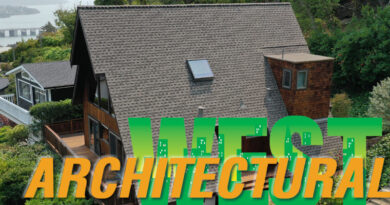Natural Lighting
The Sky is the Limit When Addressing Daylighting
by Glenn Ferris, FGIA Fenestration Standards Specialist

(Editor’s Note: Glenn Ferris began his career with the Fenestration and Glazing Industry Alliance (FGIA) in 2018. He has extensive experience in the fenestration industry dating back to 1992. He is a liaison for many councils, committees, and study/work/task groups guiding them in the completion of the scope of each group. He can be reached at gferris@fgiaonline.org.)
As the fenestration standards specialist for the Fenestration and Glazing Industry Alliance (FGIA), I am all about fenestration, particularly creative applications of the windows, doors, and skylights. While taking a walk the other day, I passed an older home with a half-cathedral roof naturally illuminated by large, narrow-profile, angled-picture windows, paralleling the slope of the roof. It reminded me of a trend we have seen from a lot of window manufacturers: what were once fixed, and often custom, options are readily available in all kinds of much larger shapes and sizes. They boast equally creative spins on operating mechanisms, be they casement, sliding, or even classic, double-hung styles. Clearly, floor-to-ceiling fenestration is on trend.
While the sight of clerestory fenestration brought a smile to my face, it also reminded me of an architectural term: the missing middle. The idiom refers to a lack of affordable, available, non-utilitarian housing, from townhomes to multifamily, but in terms of daylighting efforts, it is a lack of complementary top-lighting, namely skylights.
To meet this need, FGIA developed an extensive top-lighting document: the AAMA SKY-3, Skylight Selection and Daylighting Design Guide, including Unit Skylights, Tubular Daylight Devices, and Sloped Glazing.
Some benefits of daylighting include reducing the need for artificial lighting in a space and the potential for increased productivity thanks to the presence of natural light. Plus, good daylighting design is tied to energy savings in many ways. The obvious one is lighting energy, which can represent a major portion of the total energy consumed by many buildings.

With daylight comes free heat, which can save energy during the cooler seasons. Some products used mainly for providing natural light can also significantly reduce the amount of heat lost when substituted for more traditional products.
Top-lighting, such as from a skylight, can provide daylight and solar energy throughout the interior of a low-rise building, on the top floor of a building, or in an atrium. It should complement side-lighting in any good daylighting design, where conditions permit:
• Daylight is consistently available throughout the day from both ambient lighting from the sky and direct exposure to the sun.
• Shading to avoid direct sun may be necessary when the sun is high in the sky. Modern transparent and/or translucent glazing can be utilized to avoid glare, aid in capturing sunlight at low angles and diffuse light to wider areas of floor space.
• Shading accessories can be used on many product options to manage light levels when desired or necessary.
• Even on a cloudy day, top-lighting can provide excellent daylight.
AAMA SKY-3 touches on many other important matters:
• Meeting energy codes, such as ASHRAE 90.1 and 189.1, which also help deliver net-zero projects.
• Appropriate places and spaces in varying facility types of commercial, institutional, residential, and even industrial markets that are suitable for top-lighting.
• Layout and spacing guidelines for skylights and light wells.
• Types, options and suitability guidelines.
• Environmental sustainability.
To the latter point of environmental sustainability, FGIA has been instrumental in helping to develop a workable new business-to-business Product Category Rule for fenestration assemblies. The evaluation of “cradle-to-gate” impacts, as prescribed largely by ISO standards, can also be used by skylight products.
Returning to the “missing middle” in housing, there is an economic benefit to bringing top-lighted fenestration to affordable housing. The federal government recently introduced its Justice 40 initiative, where it will provide up to 40 percent funding for projects that help deliver housing that improves energy efficiency, impact on clean water and wastewater infrastructure, and environmental sustainability in disadvantaged communities that are marginalized by underinvestment and/or overburdened by pollution.
Homes of all kinds, as well as businesses or schools, can be elevated into healthy, productive, and inspiring spaces thanks to light from above.
